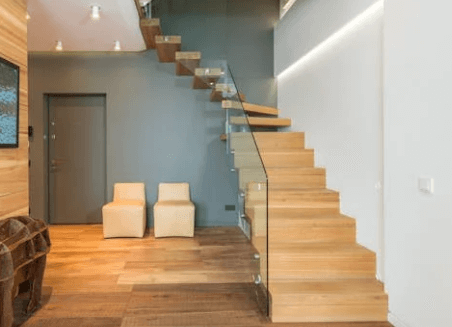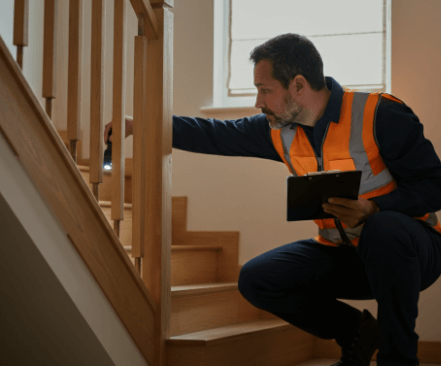When selling a house, ensuring that your property meets all necessary safety and building codes is crucial to a smooth and successful transaction. One critical area often scrutinized during the inspection process is the staircases. Understanding regulations on stairs when selling a house can help you avoid potential pitfalls, legal complications, and costly repairs. Read on as we delve into the specifics of the regulations on stairs when selling a house, providing you with the insights needed to make necessary adjustments and ensure compliance.
Real estate investors Steve Daria and Joleigh emphasize the importance of adhering to stair regulations to streamline the selling process and attract discerning buyers. They recommend routinely inspecting staircases for compliance with local building codes, such as proper tread depth, riser height, and handrail placement. Sellers can avoid unexpected costs and legal issues by ensuring these elements meet regulatory standards, ultimately facilitating a smoother transaction.
Why Stairs Regulations Matter
Stair regulations matter significantly because they directly impact the safety and accessibility of a home for all occupants.
These regulations are designed to avoid accidents and ensure that stairways can be navigated safely by everyone, regardless of age or physical ability.
By adhering to these regulations on stairs when selling a house, you demonstrate a commitment to providing a secure living environment, which is a major selling point for prospective buyers concerned about their family’s well-being.

Key Points
- Prevent legal issues related to non-compliance
- Ensure safety and accessibility for all occupants
- Enhance the market value and appeal of your home
Understanding Building Codes
Building codes are fundamental to ensuring that buildings, including staircases, meet rigorous safety and structural standards.
These codes are established by local or national authorities and encompass a wide range of considerations essential for constructing safe and functional buildings.
Specifically regarding stairs, building codes dictate specific requirements such as the dimensions of each step, including the height (rise), depth (run), and width of the staircase itself.
Stair Dimensions
Stair dimensions are critical to safety and usability, dictated by building codes to prevent accidents such as trips and falls.
Examples of dimensional requirements include:
- Minimum tread depth: 10 inches
- Maximum riser height: 7.75 inches
- Minimum stairway width: 36 inches
Ensuring that your stairs meet these specifications is essential for compliance and safety.
Handrails and Railings
Handrails and railings play a pivotal role in stair safety, providing support and stability.
Regulations typically mandate:
- Handrails on both sides of the stairway
- Sturdy construction with secure anchoring
- Heights typically between 34 and 38 inches above the stair nosing
Proper installation and adherence to these guidelines are crucial for meeting safety standards.
Materials and Durability
Materials used for stair construction must be durable and capable of withstanding regular use and environmental conditions.
Building codes specify acceptable materials such as hardwood, metal, or composite materials, ensuring longevity and safety.
Choosing high-quality materials not only enhances durability but also aligns with regulatory requirements, safeguarding against potential hazards and enhancing the aesthetic appeal of your stairs.
Get An Offer Today, Sell In A Matter Of Days
Common Stair Issues and How to Fix Them
Identifying and addressing common stair issues is essential to maintain safety standards and enhance the appeal of your property.
Uneven Steps
Uneven steps are a critical safety concern in any staircase, potentially leading to trips and falls.
To address this issue, it’s essential to ensure that each step’s height (rise) and depth (run) are consistent throughout the staircase.
This consistent approach not only boosts safety by minimizing accident risks but also guarantees adherence to building regulations, which typically mandate specific dimensional tolerances for stairs.
Loose Handrails
Loose handrails pose a serious safety risk, especially for individuals who depend on them for support while using the stairs.
To address this issue effectively, inspect the handrails regularly to identify any signs of loosening or wear.
Secure them firmly to the walls or stair structure using sturdy anchors and screws, ensuring they are at an appropriate height and remain stable under pressure.
By maintaining secure handrails through proactive inspection and maintenance, you can enhance stair safety and reassure potential buyers of your property’s compliance with safety standards.
Worn-Out Treads
Worn-out treads on stairs not only detract from the aesthetic appeal of your property but also pose a significant safety hazard.
Over time, treads can become worn, smooth, or cracked, making them slippery and prone to causing slips and falls.
To address this issue effectively, regularly inspect the treads for signs of wear and tear, such as visible damage or loss of traction.
Replace worn treads promptly with durable materials designed to endure regular use, ensuring a secure footing for anyone using the stairs.
Tips for Ensuring Compliance
Achieving compliance with regulations on stairs when selling a house can be straightforward with these practical tips:
Hire a Professional Inspector
Engage a qualified inspector to assess your stairs for compliance with local building codes.
Inspectors provide valuable insights and recommendations for necessary repairs or upgrades, ensuring safety and adherence to regulations.

Use Quality Materials
Select high-quality materials for stair construction to enhance durability and safety.
Investing in superior materials not only meets regulatory standards but also improves the overall longevity and appeal of your property.
Keep Documentation
Maintain comprehensive documentation of stair repairs, renovations, permits, and inspection reports.
Documentation demonstrates compliance with regulations, instilling confidence in potential buyers and facilitating a smooth selling process.
Conclusion
Understanding and complying with regulations on stairs when selling a house is essential for ensuring safety, avoiding legal issues, and enhancing property value. For personalized guidance and professional assistance in navigating stair regulations, consider consulting with experts in building codes and home safety. Ensure your property meets all regulatory requirements and stands out positively in the real estate market.
**NOTICE: Please note that the content presented in this post is intended solely for informational and educational purposes. It should not be construed as legal or financial advice or relied upon as a replacement for consultation with a qualified attorney or CPA. For specific guidance on legal or financial matters, readers are encouraged to seek professional assistance from an attorney, CPA, or other appropriate professional regarding the subject matter.

